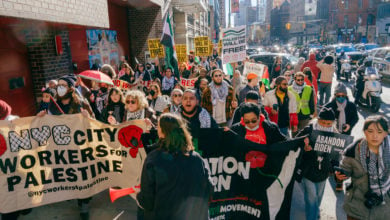The Bush administration would like the trials of prisoners at Guantánamo to legitimize its assaults on basic human rights and validate its criminal “war on terror.” But whether the government likes it or not, the trials will put its widespread use of torture under a spotlight.
|
The White House rejects the word “torture,” but a description of some of the “enhanced interrogation techniques” it instituted in March 2002 make the case all too clear. In one practice called “long time standing,” prisoners were forced to stand for more than 40 hours while handcuffed and their feet shackled to the floor. In the “cold cell,” prisoners were forced to stand naked in a room kept near 50 degrees, as they are constantly doused with cold water.
Administration officials have testified that these “techniques”—all clearly in violation of the Geneva Conventions—are not torture. Progressives and people of all political leanings have rightly protested such monstrous actions that have targeted men and women who should have never been imprisoned in the first place.
But it is important to look at how torture is woven into the very fabric of U.S. history. There are those who believe the practices of the Bush administration are deviations from the norms of U.S. military conduct, and that consequently doing away with Bush will rectify these wrongs. Their conclusions and premises are both incorrect.
Torture has always been used as a weapon of subjugation from the early colonial days. Slave owners in the American South, fearing the possibility of uprisings, used terror to punish slaves and break their will. Slaves were branded, whipped, mutilated, forced under water and shackled to bring them into submission.
The U.S. torture practices respect no borders. In 1898, the United States invaded the Philippines. At least one of the leading officers had participated in the 1891 slaughter of 350 Lakota men, women, and children at Wounded Knee. Drumming up support for the war along with the rest of the media, the San Francisco Argonaut noted, “The islands are enormously rich, but unfortunately they are infested with Filipinos.”
Several hundred thousand Filipinos were slaughtered, and the “water cure” remains one of the most barbaric legacies of the war. The horrific torture consisted of immobilizing victims on the ground by holding their arms and legs, then placing a stick in their mouth to keep it open. Soldiers would then proceed to pour water into the prisoner’s mouth and nose. A. F. Miller, a soldier of the 32nd Volunteer Infantry Regiment, wrote about the water cure in a letter: “They swell up like toads. I’ll tell you it is a terrible torture.”
U.S. soldiers were tried and convicted of torture-related crimes committed against Filipinos. This was clearly a case of scapegoating a handful of soldiers for widespread practices ordered by their superiors. U.S. soldiers in Vietnam tortured suspects and communist sympathizers by forcing their heads under water. The abominable U.S. military practices—inflicting enormous suffering through the use of white phosphorous and napalm—amounted to large-scale, indiscriminate torture.
While the Bush administration should be held accountable for its unspeakable crimes against humanity, progressives must not settle for punishing the agent while letting off the hook the real culprit. U.S. imperialism has no intention of giving up this heinous tool that has served the interests of the powerful and wealthy so well over the centuries.







